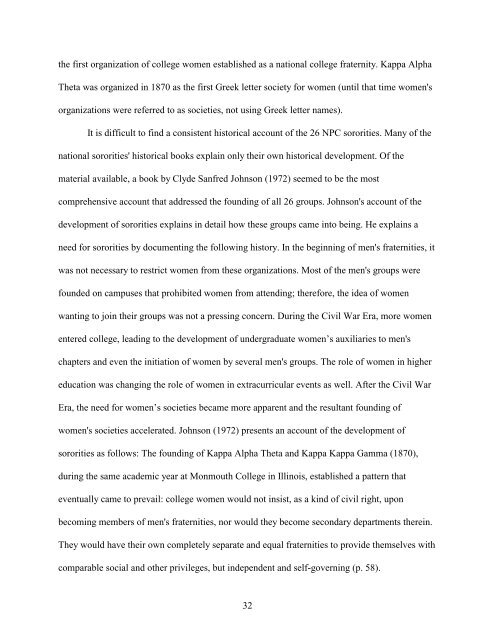Sorority Rituals - Reflections On Rites of ... - Mari Ann Callais
Sorority Rituals - Reflections On Rites of ... - Mari Ann Callais
Sorority Rituals - Reflections On Rites of ... - Mari Ann Callais
You also want an ePaper? Increase the reach of your titles
YUMPU automatically turns print PDFs into web optimized ePapers that Google loves.
the first organization <strong>of</strong> college women established as a national college fraternity. Kappa Alpha<br />
Theta was organized in 1870 as the first Greek letter society for women (until that time women's<br />
organizations were referred to as societies, not using Greek letter names).<br />
It is difficult to find a consistent historical account <strong>of</strong> the 26 NPC sororities. Many <strong>of</strong> the<br />
national sororities' historical books explain only their own historical development. Of the<br />
material available, a book by Clyde Sanfred Johnson (1972) seemed to be the most<br />
comprehensive account that addressed the founding <strong>of</strong> all 26 groups. Johnson's account <strong>of</strong> the<br />
development <strong>of</strong> sororities explains in detail how these groups came into being. He explains a<br />
need for sororities by documenting the following history. In the beginning <strong>of</strong> men's fraternities, it<br />
was not necessary to restrict women from these organizations. Most <strong>of</strong> the men's groups were<br />
founded on campuses that prohibited women from attending; therefore, the idea <strong>of</strong> women<br />
wanting to join their groups was not a pressing concern. During the Civil War Era, more women<br />
entered college, leading to the development <strong>of</strong> undergraduate women’s auxiliaries to men's<br />
chapters and even the initiation <strong>of</strong> women by several men's groups. The role <strong>of</strong> women in higher<br />
education was changing the role <strong>of</strong> women in extracurricular events as well. After the Civil War<br />
Era, the need for women’s societies became more apparent and the resultant founding <strong>of</strong><br />
women's societies accelerated. Johnson (1972) presents an account <strong>of</strong> the development <strong>of</strong><br />
sororities as follows: The founding <strong>of</strong> Kappa Alpha Theta and Kappa Kappa Gamma (1870),<br />
during the same academic year at Monmouth College in Illinois, established a pattern that<br />
eventually came to prevail: college women would not insist, as a kind <strong>of</strong> civil right, upon<br />
becoming members <strong>of</strong> men's fraternities, nor would they become secondary departments therein.<br />
They would have their own completely separate and equal fraternities to provide themselves with<br />
comparable social and other privileges, but independent and self-governing (p. 58).<br />
32



